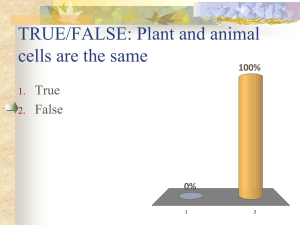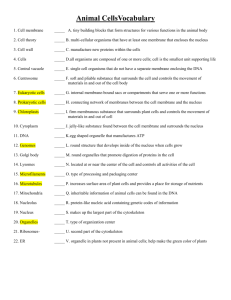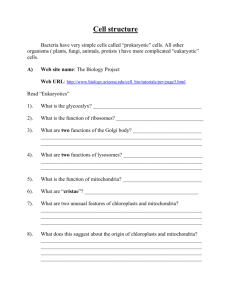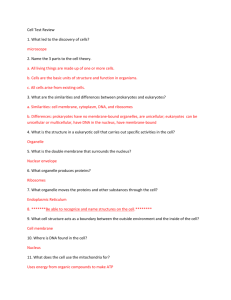Supplemental Documents
advertisement
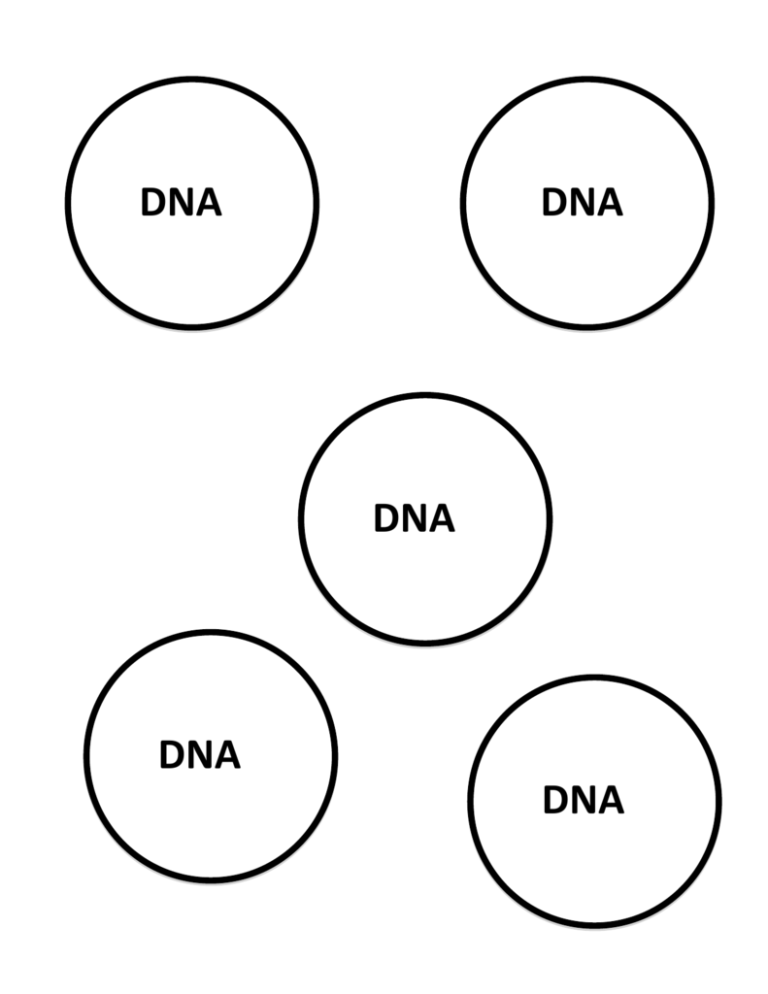
DNA DNA DNA DNA DNA RNA RNA RNA RNA RNA Hydrophobic Hydrophobic Hydrophilic Hydrophilic Somewhere . . . inside a cell Answer the following questions about the cells in your body. 1. Name the organelle in which DNA is stored. Answer:_________________________________________ 2. True or False. DNA is single-stranded. Answer:__________________________________________ 3. Name the organelle that makes most of the cell’s energy. Answer:___________________________________________ 4. Circle the correct answer. What is the largest organelle in an animal cell? a. Mitochondria b. Golgi Apparatus c. Nucleus d. Lysosome 5. Name the three parts of the Cell Theory. 1. ____________________________________________________ 2. ____________________________________________________ 3._____________________________________________________ 6. True or False. Most proteins are made in the nucleus. Answer:___________________________________________________ 7. True or False. The cell membrane is semi-permeable. Answer:___________________________________________________ 8. Circle the correct answer. What organelles are found in both plant and animal cells? a. Nucleus, large central vacuole, mitochondria b. Chloroplast, mitochondria, ribosome c. Ribosome, cell wall, nucleus d. Cell membrane, nuclear membrane, rough endoplasmic reticulum 9. Name the organelle where mRNA is produced. Answer:___________________________________________________ 10. For the DNA strand below, write in the sequence of nucleotides for the growing mRNA strand: (the first few have been done to help you) DNA strand: 5’ mRNA strand: A T G A T G A C G G C A T C A T G A T TC 3’ 3’ U A C 5’ The Emerald City Review 1. Use this sheet to draw a typical plant cell. Trace the following path in the cell 1) mRNA being made from DNA, 2) proteins being made from mRNA, 3) proteins being packaged into vesicles, 4) vesicles being released into the cytoplasm, and 5) proteins being degraded after no longer needed in the cell. Circle the organelle responsible for producing sugar in the plant cell. Protein Structure Docking Station Nucleus Nuclear pore Endoplasmic Reticulum (ER) Trans Cis Mitochondria Lysosome Cell of Ozland Welcome to Oz! As you begin your journey into the eukaryotic cell, be certain to stay on the Yellow Microtubule Road as you move from organelle to organelle. When your teacher allows you to enter the cell be careful as you move across the plasma membrane and enter the nucleus. Station 1: Nucleus 1. Grab a DNA badge on the back of a chair in the nucleus. One important process that takes place in the nucleus is transcription. Transcribe the following DNA sequence into mRNA : DNA: TACGATCCGGCAATC RNA: A U G _______________________ 2. After you transcribe your DNA, you are ready to move onto the Endoplasmic Reticulum. Station 2: Endoplasmic Reticulum (ER) 1. Sit down at the Endoplasmic Reticulum. Notice that this piece of ER has ribosomes on it. So, this is (circle one: ( rough / smooth ) ER. 2. Use a codon chart to translate the mRNA you made into amino acids. For example, the first codon is AUG and produces methionine. _________________________________________________________________________________________________ _________________________________________________________________________________________________ _________________________________________________________________________________________________ 3. After you have translated your mRNA into amino acids, make your protein. Represent each amino acid by a particular color pipe cleaner. Feel free to bend, twist, and coil your amino acids. Your newly synthesized protein should have 5 different colors, each corresponding to each amino acid you translated. After your protein is made, go onto the Golgi apparatus. Station 3. Golgi Apparatus 1. Grab a small vesicle (sandwich bag) from the cis face and take a seat in the Golgi. 2. Package your protein into the vesicle. Be sure to place three phosphate groups in your vesicle before moving on to the mitochondria. 3. The protein that you made can act as a channel that will allow you to enter the mitochondria of the cell. Station 4. Mitochondria 1. Follow the worksheet to make a pinwheel. 2. After making the pinwheel, blow on it and produce some wind energy. 3. The main job of the mitochondria is to produce energy for the cell. 4. After this, feel free to take your energy machine with you and throw away your vesicle into the lysosome for degradation. 5. If you haven’t done so, visit the hydrophobic vs. hydrophilic station as well as the protein structure station. Somewhere . . . inside a cell Answer the following questions about the cells in your body. 1. Name the organelle in which DNA is stored. Answer:_________________________________________ 2. True or False. DNA is single-stranded. Answer:__________________________________________ 3. Name the organelle that makes most of the cell’s energy. Answer:___________________________________________ 4. Circle the correct answer. What is the largest organelle in an animal cell? e. Mitochondria f. Golgi Apparatus g. Nucleus h. Lysosome 5. Name the three parts of the Cell Theory. 1.__________________________________________________________ 2.__________________________________________________________ 3.__________________________________________________________ 6. True or False. Most proteins are made in the nucleus. Answer:___________________________________________________ 7. True or False. The cell membrane is semi-permeable. Answer:___________________________________________________ 8. Circle the correct answer. What organelles are found in both plant and animal cells? e. Nucleus, large central vacuole, mitochondria f. Chloroplast, mitochondria, ribosome g. Ribosome, cell wall, nucleus h. Cell membrane, nuclear membrane, rough endoplasmic reticulum 9. Name the organelle where mRNA is produced. Answer:___________________________________________________ 10. For the DNA strand below, write in the sequence of nucleotides for the growing mRNA strand: (the first few have been done to help you) DNA strand: mRNA strand: 5’ A T G A T G A C G G C A T C A T G A T T C 3’ 3’ U A C Somewhere . . . inside a cell Answer the following questions about the cells in your body. 1. Name the organelle in which DNA is stored. Answer: Nucleus. 2. True or False. DNA is single-stranded. Answer: False 3. Name the organelle that makes most of the cell’s energy. Answer: Mitochondria 4. Circle the correct answer. What is the largest organelle in an animal cell? i. Mitochondria j. Golgi Apparatus k. Nucleus 5’ l. Lysosome 5. Name the three parts of the Cell Theory. 1._All living things are composed of cells. 2. Cells come from cells. 3. A cell is the smallest unit of life. 6. True or False. Most proteins are made in the nucleus. Answer: False. 7. True or False. The cell membrane is semi-permeable. Answer: True. 8. Circle the correct answer. What organelles are found in both plant and animal cells? i. Nucleus, large central vacuole, mitochondria j. Chloroplast, mitochondria, ribosome k. Ribosome, cell wall, nucleus l. Cell membrane, nuclear membrane, rough endoplasmic reticulum. 9. Name the organelle where mRNA is produced. Answer: Nucleus 10. For the DNA strand below, write in the sequence of nucleotides for the growing mRNA strand: (the first few have been done to help you) DNA strand: 5’ A T G A T G A C G G C A T C A T G A T T C 3’ mRNA strand: 5’ 3’ U A C U A C U G C C G U A G U A C U A A G



